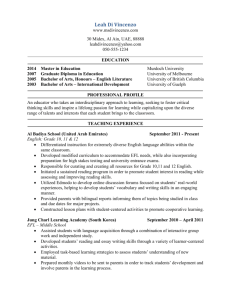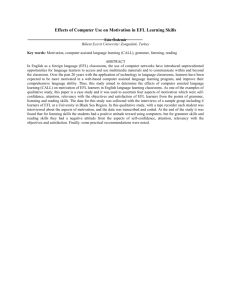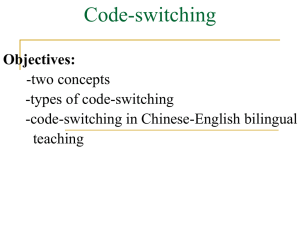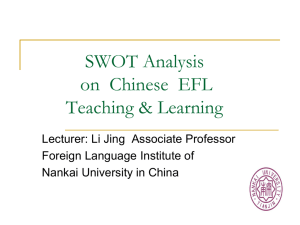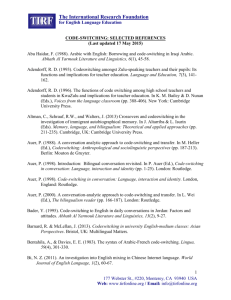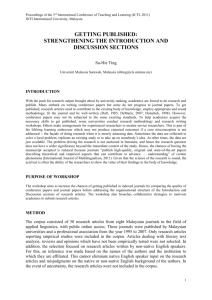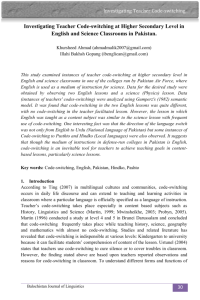4A0C0044 李慈恩 Coco The role of the L1 as a scaffolding tool in
advertisement
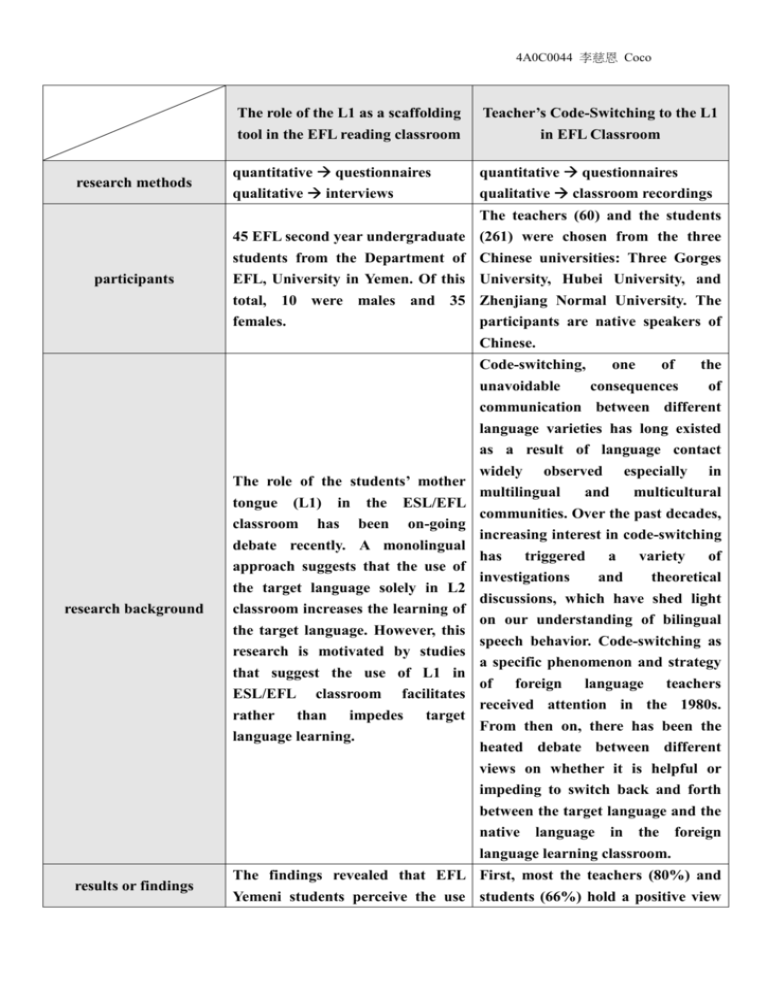
4A0C0044 李慈恩 Coco research methods participants The role of the L1 as a scaffolding tool in the EFL reading classroom Teacher’s Code-Switching to the L1 in EFL Classroom quantitative questionnaires qualitative interviews quantitative questionnaires qualitative classroom recordings 45 EFL second year undergraduate students from the Department of EFL, University in Yemen. Of this total, 10 were males and 35 The teachers (60) and the students (261) were chosen from the three Chinese universities: Three Gorges University, Hubei University, and Zhenjiang Normal University. The females. participants are native speakers of Chinese. research background Code-switching, one of the unavoidable consequences of communication between different language varieties has long existed as a result of language contact widely observed especially in The role of the students’ mother multilingual and multicultural tongue (L1) in the ESL/EFL communities. Over the past decades, classroom has been on-going increasing interest in code-switching debate recently. A monolingual has triggered a variety of approach suggests that the use of investigations and theoretical the target language solely in L2 discussions, which have shed light classroom increases the learning of on our understanding of bilingual the target language. However, this speech behavior. Code-switching as research is motivated by studies a specific phenomenon and strategy that suggest the use of L1 in of foreign language teachers ESL/EFL classroom facilitates received attention in the 1980s. rather than impedes target From then on, there has been the language learning. heated debate between different views on whether it is helpful or impeding to switch back and forth between the target language and the native language in the foreign language learning classroom. results or findings The findings revealed that EFL First, most the teachers (80%) and Yemeni students perceive the use students (66%) hold a positive view 4A0C0044 李慈恩 Coco of Arabic (L1) as a useful on teachers’ code-switching to the facilitating tool in their learning of English as a foreign language. Besides, the findings also suggest that the use of Arabic may usefully serve social and cognitive functions, including scaffolding, and promote collaborative work to facilitate language learning. L1. Second, the dominant pattern, one of the three patterns of code-switching, is inter-sentential code-switching. Third, the factors like teachers’ attitudes towards code-switching, traditional methods, and situational factors also contribute to the occurrence of the switching to the L1. Fourth, code-switching to Chinese has been found to serve various functions. Fifth, code-switching to Chinese is a good strategy of efficiency and benefits EFL classroom. implications for teaching and research Code-switching to Chinese is a prevalent phenomenon in EFL L1 can be used by the teacher as a classroom of Chinese universities pedagogical strategy to facilitate and that it plays a significant role in students’ learning and to maximize English learning and teaching their engagement in the classroom. process. However, there are However, teachers should make admittedly still some limitations sure that students are not which may give some directions for increasingly or extremely further studies. First, the data dependent on L1. This balance source could not fully represent the should be exponential in that as whole population of EFL teachers the student’s proficiency in the and students. Second, the target language increases, the respondents may have answered the dependence of L1 decreases. questions in the questionnaires with Finally, the issue of the role of L1 subjective minds. Third, maybe in the EFL classroom can be there are other kinds of further investigated, especially code-switching with different from the teacher’s perspective, to patterns, factors, or functions in draw a better pedagogical decision EFL classrooms. Fourth, some on the way that L1 could be variables were not accounted for in integrated in the teaching this study, such as students’ methodologies. education level, gender, learning motivation,etc. 4A0C0044 李慈恩 Coco The role of the L1 as a scaffolding tool in the EFL reading classroom 1. (Adequately) synthesize prior literature? Yes. The researchers synthesize the advocators of the monolingual approach and the proponents of using the L1 in the L2 classroom. The researchers synthesize the use of L1 in two different perspectives. (1) Cognitive perspective (2) Sociocultural perspective 2. (Adequately) interpret prior literature? Yes. The researchers interpret “L1 in the EFL classroom.” 3. (Adequately) critique prior literature? Yes. “There is no empirical evidence that L1 has an impeding role in the EFL/ESL classroom in non-native environments especially.” 4. Are the references included relevant? Yes. The researchers provide a number of references which are relevant to the topic. 5. Are the reviewed references current? Not really. This journal is in 2014. However, there are some references before 2000. 6. Is the scope (breadth and depth) of LW adequate? Yes. 7. Adequately introduce the research background/context? Yes. “The role of the students’ mother tongue (L1) in the ESL/EFL classroom has recently been the focus of an on-going debate and research.” 8. Adequately justify RQ’s/purposes or define research issues proposed? Yes. “This paper reports on a research investigating the students’ perception of using the (L1) in the EFL reading classroom at a tertiary context in Yemen.” 9. Review literature in terms of research findings? 4A0C0044 李慈恩 Coco Yes. “Other researchers have in fact, shown that students’ mother tongue (L1) foster a positive affective learning environment, especially in the beginning and intermediate classes…” 10. Review literature in terms of research methods? Yes. “The current study employed a mixed method design where both qualitative and quantitative data collection are conducted concurrently in an embedded mixed methods approach.” 11. Review literature in terms of significance of study? Yes. “In the EFL context, there appears to be an increasing conviction that the use of L1 in the EFL Classroom has a necessary and facilitating role.” 12. Review literature in terms of other aspects? Yes. “L1 should not be used in the EFL classroom and that only target language should be used to provide students with sufficient practice in the target language. This argument completely denies the fact that students use and need to use the L1 for a variety of reasons.” 4A0C0044 李慈恩 Coco Teacher’s Code-Switching to the L1 in EFL Classroom 1. (Adequately) synthesize prior literature? Yes. In the studies of code-switching, there have been various definitions of the term “code-switching.” “Attempts have been made to describe and classify the various reasons and functions of the uses of L1 in teacher speech.” 2. (Adequately) interpret prior literature? Yes. “To be brief, code-switching is the shift from one language to another within a conversation or utterance… ” “In short, it is not only impractical to exclude the L1 from the classroom but it is also likely to deprive students of an important tool for language learning.” 3. (Adequately) critique prior literature? Yes. “However, much of the research is concerned about the situations in English-speaking countries, where English is the L1 and French, in most cases, the TL.” 4. Are the references included relevant? Yes. “There have been many attempts to give a typological framework to the phenomenon of code-switching” 5. Are the reviewed references current? Not really. This journal is in 2010. However, there are some references before 2000. 6. Is the scope (breadth and depth) of LW adequate? Yes. 7. Adequately introduce the research background/context? Yes. “Over the past decades, increasing interest in code-switching has triggered a variety of investigations and theoretical discussions, which have shed light on our understanding of bilingual speech behavior. Code-switching as a specific phenomenon and strategy of foreign language teachers received attention in the 1980s. From then on, there has been the heated debate between different views 4A0C0044 李慈恩 Coco on whether it is helpful or impeding to switch back and forth between the target language and the native language in the foreign language learning classroom.” 8. Adequately justify RQ’s/purposes or define research issues proposed? Yes. “The present paper aims to prove that teachers’ code-switching to the L1 plays a positive role in the EFL classroom of Chinese universities by investigating the terms of the attitudes of the teachers and students towards, the patterns, the factors, the functions, and the influence of the code-switching to the L1.” 9. Review literature in terms of research findings? Yes. “The findings cannot be generalized before more experiments are repeated in other environments in order to account for classroom code-switching, as the discrepancy between these two language systems is much smaller than that between other languages…” 10. Review literature in terms of research methods? Yes. “In order to have a general and genuine reflection of teachers’ code-switching in classroom, both qualitative and quantitative research methods were used, consisting of two questionnaires and classroom recordings.” 11. Review literature in terms of significance of study? Yes. “The studies above have made great contributions to the studies of teachers’ code-switching in FL classroom.” 12. Review literature in terms of other aspects? Yes. “There may be a different picture due to the greater language and cultural differences.”

